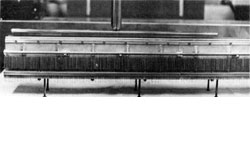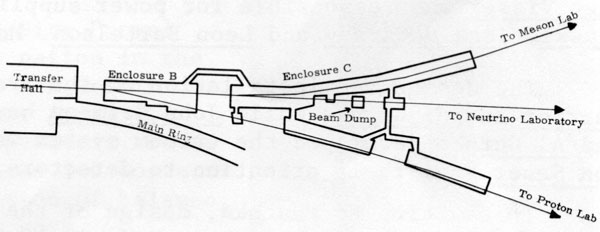NAL Beam Headed Toward Experimental Areas
PROGRESS REPORT - APRIL 17 THROUGH APRIL 22, 1972
An 80 BeV beam was extracted from the Main Ring and was detected in the Neutrino Target Hall at 9:50 p.m. on Friday, April 21. The accelerator was set on a 200 BeV ramp on Saturday, April 22, and extraction studies continued.
With accelerated beam circulating in the NAL Main Ring, the spotlight turned to the Switchyard section. It was this group's equipment that reached out and grabed the proton beam as it flew around the Ring 50,000 times per second and sent it to the experimental targets where the protons interact with target material.
Following the achievement of 200 BeV acceleration in the Main Ring on March 1, 1972 efforts immediately turned to extracting the beam from the Main Ring and guiding it to the experimental areas. On March 6th, about 5% of the circulating beam was extracted. On March 10, a beam spot was located further down in the Transfer Hall; on April 14, a beam of 3 x 109 protons was detected in Enclosure B. Then, on April 16, beam was obtained still farther down the line in the Beam Dump opposite the Meson line switch at Enclosure C. Finally, on Friday, April 21, a beam of 1 x 1010 protons was detected in the New Hall of the Neutrino Laboratory, some 3,200 feet from the Transfer Hall. The next step was to direct beam to the 30" Bubble Chamber located beyond the end of the Neutrino Laboratory area, approximately two miles from the Transfer Hall.
When full machine intensity is reached, efficiency of extraction must be greater than 99% in order to avoid the radioactivity that would result from beam lost at the extraction point. Extraction begins in an electrostatic septum 100 feet upstream of a long straight section of the Main Ring that also contains the injection system for the 8 BeV beam from the Booster into the Main Ring. The 20 ft. septum consists mainly of tungsten wires spaced .040 inches apart, resembling a thousand piano strings. The septum device is the most delicate element of the extraction system. It must provide enough bending to allow the beam it grasps to clear the Main Ring components at the straight section; the septum's field cannot affect the Main Ring during acceleration, and it must be thin enough so that it does not intercept any significant fraction of the beam. The electrostatic septum deflects the beam horizontally outward from the Main Ring. After drifting about 100 feet, it enters a Lambertson septum magnet which bends the beam downward. A series of specially-designed magnets, designated as "C" and "H" magnets, then guide the beam to a pipe in the tunnel wall that leads to the Switchyard. Beam transport from then on is much the same as in the Main Ring - by means of a series of dipoles and quadrupoles that send the beam to the desired experimental area.
The NAL extraction system was originally designed for "slow" extraction. In order to simplify the adjustments needed to bring the beam through the system for the first time, it was decided to provide for "fast extraction" at the present time. Fast extraction was also useful for bubble chamber experiments such as those which will occur shortly in NAL's 30" bubble chamber. Slow extraction required additional work on the system and was needed for many experiments whose detectors would be swamped by high intensities under fast spill conditions.
During the spring, 1972 accelerator shut-down period, the Switchyard Section incorporated a number of changes necessary to initiate the fast extraction. One-meter dipoles originally bumped the beam slowly into the wires of the electrostatic septum. While this technique was fairly efficient for extraction (maybe 80%), it required that the bumped beam be very parallel to the carefully-aligned wires.
According to physicist Richard Mobley, "It was decided to install a 'super-pinger' to give the circulating bunch of protons a .8 inch displacement at the electrostatic septum in a single Main Ring turn. The coils of the pinger were timed to reach their peak just as the 1.5 microsecond Main Ring bunch passed through them."
Mobley also reported, "A further refinement was the installation of another dipole bump system, placed to control the angle of the bumped beam at the electrostatic septum. Scintillator flags, ferrite core intensity monitors, and segmented wire ion chambers were also installed for beam detection."
The present Switchyard Section evolved from the former Beam Transfer Section that was headed by Al Maschke. Ed Bleser headed Switchyard commissioning. Group organization was defined by the nature of the elements of the system. For example, Richard Andrews, Dick Krull and Butch Bianci were associated with the electrostatic septum; Claus Rode and Bob McCracken worked on the magnetic channel. Aage Visser was responsible for power supplies. Rode also developed controls with Ken Sowinski, Jack McCarthy and Leon Bartelson. McCarthy and Bob Oberholtzer produced the pinger.
The design and installation of the Transport system was under Dick Mobley, Ron Currier and Al Guthke while John Grimson was responsible for the Beam dump. Rudy Nissen and Al Guthke developed the vacuum system while Dick Biwer, Les Oleksiuk, Fred Hornstra and Jon Sauer gave their attention to detectors. Helen Edwards helped with the tuning.
In addition to Maschke, design of the Switchyard system was performed by Les Oleksiuk, Dick Mobley, Bob Daniels, Claus Rode, John Simon and Herman Stredde. Bob Scherr, Ed Tilles, and Joe Otavka supervised construction of the many specially-designed magnets and control equipment needed for this highly-complicated system. Bill Vallas of DUSAF was the architect. The group, numbering 70 in peak periods, also included many other technicians and design personnel. They "delivered" the proton beam that experimenters were waiting for.






























